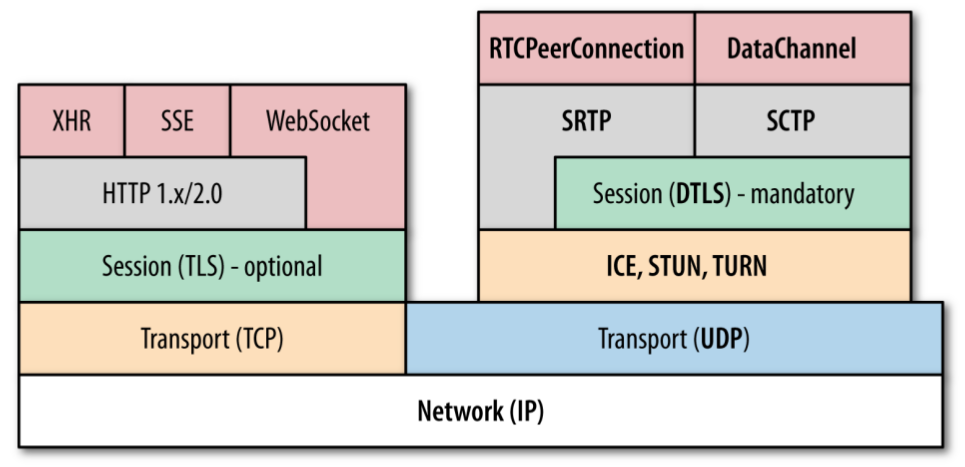WebRTC Architecture
We will be looking at:
- Networking
- Protocol stack
- Codec Negotiation
- Case: Video Conferencing
TCP versus UDP
|
TCP
|
UDP
|
Networking
A client connects
Second clients connects
In the home network
Client connects to server
The gateway performs NAT
And does housekeeping
Peer-to-peer TCP won’t work
STUN to the rescue
STUN - Session Traversal Utilities for NAT
Have an external server answer the questions:
- “What is my external IP?”
- “What is my external port?”
var ice = {"iceServers": [
{"url": "stun:23.21.150.121"},
{"url": "stun:stun.l.google.com:19302"},
]};
Bad Luck
Sometimes a connection fails:
- (company) firewall
- WiFi without client interconnect
- network topologies
Then use TURN - Traversal Using Relays around NAT
⇒ Traffic is relayed, no longer P2P!
var ice = {"iceServers": [
{"url": "stun:23.21.150.121"},
{"url": "stun:stun.l.google.com:19302"},
{"url": "turn:user@turnserver.com", "account": "********"}
]};
WebRTC simplifies with ICE
ICE - Interactive Connectivity Establishment
Finds a PeerConnection for you
- on the local network
- using STUN
- using TURN
Security
W3C WebRTC working group requires all transmissions to be encrypted
- Media
- Data
- Control
For UDP media traffic solutions are available, e.g. SRTP. For connection-oriented traffic, DTLS was invented.
WebRTC protocol stack

SDP
Session description
v= (protocol version number, currently only 0)
o= (originator and session identifier : username, id, version number, network address)
s= (session name : mandatory with at least one UTF-8-encoded character)
i=* (session title or short information)
u=* (URI of description)
e=* (zero or more email address with optional name of contacts)
p=* (zero or more phone number with optional name of contacts)
c=* (connection information—not required if included in all media)
b=* (zero or more bandwidth information lines)
One or more Time descriptions ("t=" and "r=" lines; see below)
z=* (time zone adjustments)
k=* (encryption key)
a=* (zero or more session attribute lines)
Zero or more Media descriptions (each one starting by an "m=" line; see below)
SDP (cont)
Time description (mandatory)
t= (time the session is active)
r=* (zero or more repeat times)
Media description (if present)
m= (media name and transport address)
i=* (media title or information field)
c=* (connection information — optional if included at session level)
b=* (zero or more bandwidth information lines)
k=* (encryption key)
a=* (zero or more media attribute lines — overriding the Session attribute lines)